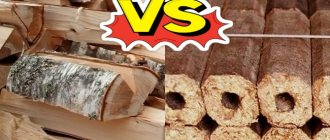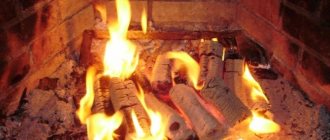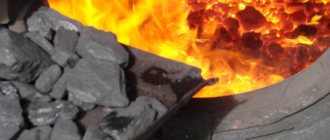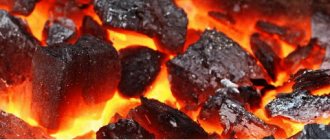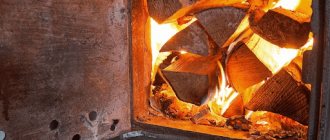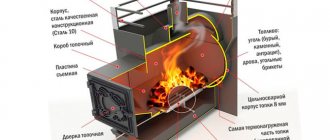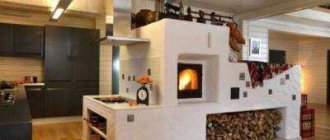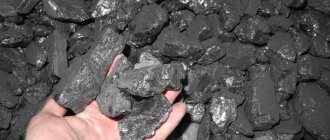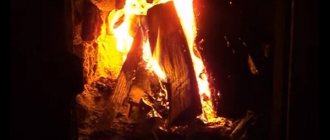Traditional wood stoves are the main source of heat in individual country houses. Moreover, many owners do not plan to exchange them for modern heating devices. This is partly easily explained by the following: today there are many alternative types of fuel - briquettes. Compared to the firewood that many are accustomed to, they are much more efficient, more convenient to use, but at the same time their cost is higher. In general, each fuel material has its own advantages and disadvantages. Therefore, the decision to choose firewood or wood briquettes always remains with the home owners. They usually assess the situation from a practical point of view and make a more profitable choice for themselves.
Stove heating with wood or other modern materials remains relevant today for many owners of country houses Source o-vannoy.ru
Fuel briquettes or firewood – which is better?
It is advisable to start comparing different types of fuel with the cost of materials. If we analyze their price indicators, 1 m3 of Euro firewood will cost approximately twice as much as the same amount of ordinary logs. Moreover, the former are made from raw materials of varying value; the price of firewood is determined by the type of wood.
There are different products on the market. First-class briquette products have a denser structure, do not contain cracks or chips, and most often they are fired on the outside. Low-quality products are multi-layered, have lower density, and are vulnerable to mechanical damage. Such fuel burns faster and produces less heat.
The cost of fuel briquettes is approximately twice as much as regular firewood Source pankornik.pl
Homemade briquettes - pros and cons
The reasons why this type of fuel is very attractive are clear. When a person has his own wood production or the opportunity to cheaply buy sawdust for briquettes, then thoughts about making them at home are quite natural. The fact is that not every heating equipment is suitable for burning sawdust. As a rule, fine wood in a conventional stove or boiler burns quickly and gives off little heat, and even half will spill into the ash pan.
To successfully burn wood waste, you need a special shaft-type or top-burning boiler. It’s quite difficult to make this; the prospect of pressing sawdust into fuel briquettes seems much brighter.
It turns out that not everything is so simple here either, and here’s why:
- Buying factory drying and pressing equipment is an unreasonably expensive undertaking. It is cheaper to purchase ready-made European firewood.
- You can make a briquette press yourself and make them in an artisanal way. But the products will be of low quality and will provide little heat, and will take a lot of time.
After squeezing out the water and subsequent drying, the briquette becomes quite light.
Point two requires clarification. Due to the impossibility of following the technology, the “bricks” after drying are light due to their low density. Their specific heat of combustion is three times lower than that of wood, which means that for heating they will need three times as much. The whole process will take a lot of time and consume a lot of energy. And it is very difficult to store such a volume of fuel so that it does not accumulate moisture.
Educational video for enthusiasts who want to start manual briquetting of various household waste:
What to choose: coal or firewood?
Coal is perfect for heating boilers located in a separate room. It is not at all recommended to use it in a stove located in the home. This is due to the fact that such fuel burns for a long period and does not burn completely. For this reason, it is unacceptable to leave the chimney closed so that carbon monoxide does not accumulate in the room. At the same time, ordinary firewood always burns completely, releasing enough heat. This means that you can safely close the valve without fear for your health or heat leakage through the chimney.
Lighting charcoal without the right wood is a difficult task. Therefore, all those who use it are forced to purchase material for ignition.
Coal dust is considered quite harmful to human health. When throwing such fuel into the stove, you must try to prevent dust from rising into the air. Firewood contains almost no dirt, making it much safer.
As opposed to coal heating, traditional wood heating is more environmentally friendly: when burned, dry wood emits a small amount of carbon dioxide and therefore does not damage the natural environment. The latter is not typical for coal.
Unlike firewood, coal is not recommended for heating stoves located in residential premises Source tektarif.ru
About security
When using Eurowood, you should follow the same safety rules as when burning any other type of fuel. You should not leave the stove unattended, completely clog the firebox, or open the vent too much.
Eurowood takes some time to ignite. Due to this, arbitrary combustion from heat or temperature is excluded if the fuel is near the stove.
Follow safety precautions!
How to make briquettes with your own hands
If firewood or briquettes are not available, you can try to make the latter yourself. The main principle of Euro-firewood production is the compression of crushed wood waste until lignin begins to be released. This substance subsequently glues small particles into a monolithic product. For the production of fuel briquettes it is allowed to use: agricultural residues, sawdust, shavings, and other woodworking waste.
Procedure:
- Grind raw material.
- Dry to 10% moisture content.
- Using a hydraulic press or auger device, briquet the prepared raw materials.
Making at home
It is clear that purchasing such powerful equipment to press briquettes at home is a fool’s errand. Even if you have the funds and free raw materials, you will be able to recoup its cost only if you press firewood from sawdust for sale. This means that it will not be possible to maintain traditional technology for lignin extraction.
Clue. Waste from winter tree pruning is perfect for briquetting if it is first crushed with a crusher. Read about the process of assembling such a branch chopper in a separate material.
Instead, home craftsmen have adapted to using different binders to form “bricks,” for example:
- wallpaper or other cheapest glue;
- clay;
- paper, corrugated cardboard.
In order not to buy expensive drying and pressing equipment, fuel briquettes are made at home as follows. Sawdust is soaked in water and thoroughly mixed with clay in a ratio of 1:10, or soaked cardboard or wallpaper glue is added. The resulting mixture for making briquettes is placed in the form of a homemade manual sawdust press and compressed by hand. Then the “brick” is removed from the mold and placed to dry naturally, outside.
For reference. Using this technology, savvy owners press briquettes from any available materials that can burn: straw, paper, cardboard, leaves, seed husks, and so on.
COMPARISON OF OPTIONS for coal briquetting with and without binder
Coal briquetting using a binder:
- +
Suitable for any hard or brown coal - +
High productivity (up to 100 t/h) - +
Low specific energy consumption - +
Possibility of obtaining moisture-proof briquettes - +
Low cost of consumables - —
More expensive and complex equipment; binder required
Briquetting coal without binder:
- —
Applicable only to certain coals - —
Drying is required - —
Limited capacity (up to 25 t/h) - —
High specific energy consumption - —
High cost of consumables - +
No binder, simpler and cheaper equipment
The technology of coal briquetting without binder additives seems more attractive at first glance, however, at the same time, energy costs increase significantly, and the productivity and quality of the briquette decreases.
Features of storing pressed sawdust
Due to an active dislike for moisture, pressed sawdust cannot be stored outdoors, as most summer residents do with their firewood. The bright sun, as well as proximity to heating elements, will not be beneficial for them.
It is best to allocate a well-ventilated room for sawdust, protected from precipitation and sunlight. This could be a closed veranda or a high-quality extension where a pleasant temperature is maintained and there is no humidity. At the same time, you should not be afraid of debris and dirt, which certainly remain after firewood and coal.
In winter frosts, briquettes can be placed under a regular canopy: during frosts, air humidity is negligible, and sawdust will not be able to absorb moisture. In this case, they will only need to be protected from contact with snow.
Additional protection will be provided by plastic film, so when purchasing it is important to check the integrity of the packaging.
Conventional cylindrical heating briquettes
Cylindrical briquettes for stoves are made from sawdust and other small woodworking waste.
They are pressed under pressure, adding a non-toxic adhesive base. The fuel is inexpensive, however, has low strength. It quickly disintegrates and crumbles if improperly transported and stored. Cylindrical briquettes are afraid of moisture. Their main advantage is their relatively low price.
Differences from other fuels
In terms of combustion mode, pressed sawdust is no different from conventional firewood or coal. But in structure they are closer to the second option, since they do not have capillaries that penetrate all the wood, so the decomposition occurs somewhat more slowly.
And sawdust is not capable of crackling comfortably. But with them you don’t have to worry about flying sparks and rebounding embers.
Using pressed sawdust
The main uses of briquettes are:
- Heating of residential and non-residential buildings;
- Ignition of decorative stoves and fireplaces;
- Use as fuel for picnics;
- Cooking in barbecues and tandoors;
- Heating baths and saunas.
An unusual way of using it is to insulate the walls and ceilings of houses, but in this case it is recommended to use ordinary sawdust.
Coal briquetting technologies
Coal briquettes are made from brown coal, chips and dust of anthracite and hard coal, semi-coke and coke breeze. Depending on the type of feedstock, binders are added or not.
The formation of briquettes from brown coal occurs without the addition of binders, since the material itself contains up to 20% bitumen. During processing, the raw materials are crushed, heated and dried, bringing the humidity to 18-20%. After cooling, the resulting crumbs are fed into a high-pressure press, where lump fuel is formed. After cooling, they can be used or improved quality characteristics in semi-coking plants.
Coal briquetting press
Briquetting of fine coals can also occur either with or without binders. During industrial production, the following substances are added as a binding element:
- petroleum bitumen;
- lignosulfonates;
- molasses;
- liquid glass;
- cement.
Liquid glass and cement are used in the processing of certain types of coal and fine coke. Such briquettes are used in metallurgy in those processes where the presence of such components is acceptable. Coal tar and petroleum bitumen are also used to produce fuels for industrial applications. Such briquettes are not suitable for heating houses: during combustion, benzopyrene and other harmful substances are released, so they are prohibited by the SES and the demand for them is very limited.
There are two briquetting technologies: with or without the addition of a binder
For briquettes for household use, starches are most often used as a binding element, which are added to the crumbs until a viscous mass is obtained. Sometimes sugar, cellulose, and molasses are added. Clay, gypsum and lime are used less frequently, as they increase the ash content and reduce the specific heat capacity of the fuel. The type and quantity of the binding component is selected based on the qualities of the coal raw material during the production process. The mechanical characteristics of the briquette serve as a guide, but the energy value of the resulting fuel is also important.
The production of coal briquettes for household use consists of the following steps:
- Drying. The less moisture in the raw material, the stronger the briquettes will be.
- Removal of volatile components. This stage is necessary when processing low grade coal containing a large amount of volatile substances. A coke oven or distillation apparatus is used for this.
- Grinding.
- Adding binders and mixing it with coal chips. This composition is called the charge.
- The mixture is fed to a press, where briquettes are formed under pressure.
- In some cases (depending on the binder used), heating in an oven to 300 o C is required.
- Cooling.
Developments in recent years have made it possible to form coal briquettes without the use of binders from any waste from the coal industry. Briquetting in such installations takes place in two stages. First, the crushed coal undergoes initial compaction by removing the voids between the particles. Then, by increasing the pressure to 100-200 Mn/m2, the particles themselves are deformed and compacted.
This is what pressed coal looks like
This releases phenols and resins, which, when water is added, form a natural binding component. The entire process is controlled by a microprocessor. The briquettes obtained in this way burn without smoke and do not emit harmful substances. Needless to say, such a coal briquetting press costs a lot? Hence the high cost of the final product. But coal of any brand is processed, the briquettes are strong, with a high calorific value, burn without smoke or any significant emissions into the atmosphere.
The calorific value of coal briquettes is 6000 kcal/k
There are several other technologies that make it possible to make coal briquettes without binders. For this purpose, special roller presses are used, but not all brands are processed in this way. In some developments, some raw materials with a high tar content (caking coals) are added to the high-grade coal crumbs. The resulting mixture is heated to the plasticization temperature of sintered coals, after which the mixture is cooled slightly and then briquettes are formed.
Advantages and disadvantages of the product
Sellers of coal briquettes insist that the calorific value of their product is significantly higher than that of other types of fuel. This may be true, since the heat of combustion of 1 kg of anthracite is 8 kilowatts, and firewood and wood-based briquettes emit up to 5 kW/kg. The advantages of briquetted coal also include:
- enlargement of particles of the initial fraction;
- reducing the volume of harmful emissions into the atmosphere during combustion;
- high quality products with standard indicators;
- ease of storage and transportation;
- ease of spending control;
- combating spontaneous combustion of fine coal;
- environmental cleanliness and absence of harmful chemical additives;
- high heat transfer;
- ease of ignition and burning duration.
https://youtube.com/watch?v=jgT9fpwDmZw
However, owners of solid fuel boilers cite a number of reasons for the low popularity of coal briquettes in comparison with their wood counterparts. The disadvantages include the following:
- the equipment is difficult to heat, and the fuel does not provide enough heat;
- when burning in the premises there are unpleasant odors;
- products crumble freely and become shapeless during transportation;
- A large amount of ash is formed.
Negative reviews are understandable if we remember that unscrupulous manufacturers, in order to obtain maximum profits, try to use charge, sludge and other coal products that are unsuitable for heating needs. Real anthracite briquettes with a rich black glossy color are difficult to find on sale. This leads to the logical conclusion that it is preferable to make coal briquettes yourself and purchase high-quality raw materials for this.
You should not waste effort and money on pressing low-calorie types of coal, although such briquettes, in proper combination with firewood, will significantly reduce overall costs during the heating season. Manufactured using a homemade method, they differ unfavorably from factory-made analogues: they produce little heat when burning, are fragile and are destroyed during transportation. But here it is possible to take care of the quality of the source material and adjust the content of additives. And the cost of homemade bricks, pillows and sausages turns out to be much more attractive than the prices of their factory-made counterparts.
BRIQUETTING COAL WITH BINDER
The plant for briquetting coal with a binder consists of the following sections:
- coal sorting and grinding area if the coal size is too large
- drying area if the moisture content of the coal is too high
- binder addition area
- briquetting area on a two-roller press
- (optional) post-processing area (cooling, ripening and drying depending on the binder used)
The capacity of a plant for the production of briquettes from coal with a binder can range from several tons per hour to 100 t/h for large presses.
Possible binders
- coal pitch
- petroleum bitumen
- resin
- molasses and lime
- lignosulfonate
- starch
- polymers, etc.
The specific binder for charcoal briquettes is determined by regional availability and end product requirements. The optimal proportions of the binder and the parameters of the finished briquette are determined during pilot testing of coal in France.
What types of briquettes are offered to consumers
Several types of briquetted fuel can be purchased on the domestic market. They differ from each other not only in shape, but also in density, and, accordingly, in the level of heat transfer. Consumers choose based on characteristics such as price, quality and practicality.
Types of fuel briquettes:
- fuel briquettes RUF;
- Euro briquettes PINI KAY;
- ordinary cylindrical briquettes;
- fuel briquettes from coal, peat.
Each type of briquetted fuel has its own pros and cons, so you can choose which one is more convenient to use in this case. Pressed sawdust for stoves, which go through a longer manufacturing process, will be more durable, calorific, but also more expensive. Quality, naturally, adds up to the price of the product.
Since briquetted fuel is quite expensive, you need to choose a really high-quality product that matches its price category. If you use high-quality wood briquettes, you can save on fuel.
Cost of wood briquettes
In Moscow and the region, you can purchase forms of this type from various tree species, often when ordering from 5 tons, the price will be changed, this is a kind of discount for a wholesale buyer.
I can only give approximate numbers, but they are worth a look. The package consists of 12 pieces, often the weight does not exceed 10 kg, which is quite convenient. I would like to highlight the following types:
- Birch sawdust – 6500 rub. per ton.
- Oak dust – 8500 rub. per ton.
- Wooden specimen made of oak – 9,700 rubles. per ton.
It is better to find out all the exact prices directly from consultants; I advise you to take a closer look at specialized sites, where you can find all the important information without leaving your private home.
COMPARISON OF OPTIONS for coal briquetting with and without binder
Coal briquetting using a binder:
- +
Suitable for any hard or brown coal - +
High productivity (up to 100 t/h) - +
Low specific energy consumption - +
Possibility of obtaining moisture-proof briquettes - +
Low cost of consumables - —
More expensive and complex equipment; binder required
Briquetting coal without binder:
- —
Applicable only to certain coals - —
Drying is required - —
Limited capacity (up to 25 t/h) - —
High specific energy consumption - —
High cost of consumables - +
No binder, simpler and cheaper equipment
The technology of coal briquetting without binder additives seems more attractive at first glance, however, at the same time, energy costs increase significantly, and the productivity and quality of the briquette decreases.
After testing, it usually becomes clear that briquetting using a binder is more economically justified, even taking into account the costs of purchasing, delivering and storing these materials.
Eurobriquettes PINI KAY
They are shaped like square pencils without lead. This hole is provided by the manufacturing technology to create additional traction. Therefore, they have very high thermal output. Before reaching consumers, the briquettes were pre-fired for strength and removal of excess moisture.
Such briquettes are more expensive than firewood and many other types of fuel. Easy to transport and fold for storage. Their shape is ideal for fireplaces. They are taken into nature instead of firewood for fire pits. There is no equivalent in terms of heat transfer to briquettes made of wood and sunflower husks using PINI KAY technology. No binders of inorganic origin are used in the production of briquettes using PINI KAY technology. They are compressed at high temperature and under high pressure. This releases the substance lignin, which glues the sawdust together.
In terms of their performance properties, PINI KAY briquettes are significantly superior to many analogues.
What is Eurowood
Sawdust logs are original briquettes created from waste from furniture production or sawmills.
They usually take the form:
- Rectangular parallelepiped;
- Hexagonal column;
- Brick or cube;
- Round log.
The shape of the briquettes does not affect the combustion process or the amount of heat generated at all. But they are all great for use not only in small home barbecues and fireplaces, but also in large ovens with automatic loading. In this case, it is necessary to select European firewood in accordance with the parameters of the loading device.
For small stoves, pellets are used, created in the form of small granules.
Industrial production
For the production of industrial briquettes, the following binders are used:
- oil bitumen mixture;
- cement;
- lignosulfonate additives;
- liquid glass;
- molasses.
To process small particles of coke and some other types of coal, cement and also liquid glass are often used. Such materials are used mainly in metallurgy, where the use of these substances is permitted.
Coal tar with petroleum bitumen is also used for the production of industrial coal briquettes. They cannot be used to heat residential buildings, as they release large amounts of benzopyrene and other toxic elements prohibited by the SES.
What are wood briquettes made from for heating stoves?
I call this type of fuel Eurowood, I was prompted to come to this conclusion by modernity and ease of use; such elements appeared relatively recently, but are already the main competitors to generally accepted logs made of natural material, which all people have known about since ancient times.
Such products can be made from known surplus production and not only, I will describe this point in detail, there are such types of raw materials as:
- Tree. Non-format materials include shavings, sawdust and bark; they are pressed on special equipment, giving each element a convenient shape. During operation and transportation, products of this type do not lose their presentation, this is due to the substance that produces natural material, it is called lignin. The liquid is similar to glue, after hardening with its help the briquettes hold their shape perfectly, the calorific value is at a high level and amounts to 5000 kcal/kg.
- Straw. The manufacturing method is similar to the previous one, I noticed that the characteristics are slightly lower, they are 4740 kcal/kg.
- Seed husk. The calorific value is quite good, 5151 kcal/kg; such elements are produced from the residues of sunflower seed processing. The oily components included in the husk can increase efficiency, but I advise you to be careful with this point, because in addition to a good flame, deposits will form on the walls of the chimney.
- Cereal waste. Similar specimens are created from rice husks, the heat transfer is not the best, it is 3458 kcal/kg.
- Peat. Briquettes of this type must be dried before pressing, and only then they are shaped. The products are small, which affects ease of transportation. When burned, such fuel can release 5000 kcal/kg. Ash of this type of form, after cleaning the tank, is often used to fertilize the land on a personal plot, which bears fruit.
- Coal dust. The waste is sifted before compacting and then shaped. I do not recommend comparing this type of product to the stone type, because it does not produce as much smoke and is much more convenient to use.
